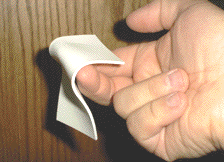[size=150]Closed Cell PVC[/size] Sintra®
**
Sintra® is the brand name for Alusuise Composites’ rigid PVC (poly vinyl chloride) foam board2, a moderately expanded, closed-cell PVC sheet. Developed in Europe in the 1970’s, Sintra® was introduced to North America in 1980, and has been used primarily in signs and displays to date. Thanks to a number of useful properties, though, Sintra® and its cousins are seeing increasing attention of late from robot builders. A fairly old material has recently found a new life in robotics.**
http://www.solarbotics.com/assets/images/sin3mm/sin3mm_pl.jpg
Iv been using this material for several of my robotic projects, and due to a few enquiry s i thought id save myself sometime in sending the same replys, by posting info here.
I find working with Sintra® very easy and it works really well.
Sintra material is closed-cell, expanded plastic, high-density poly vinyl chloride sheet. It is acid free and has minimal out gassing for Archival use. Sintra is a homogeneous material that allows the ease of cutting without regard for grain.
At half the weight of solid PVC, may be stapled, nailed, riveted, glued, and thermoformed. Forming may be done on conventional forming machines. Because this material is not hydroscopic, it needs no drying pre-forming. It is available in 9 thickness’ 1mm-13mm all thickness’ are available in white, some thickness’ are also available in White, Black, Gray, Lt Gray, Beige, Red, Yellow, Green, Blue, Lt Blue.
Cutting and Sawing - up to 3mm thick can be cut with a knife. Flat Sintra can be die cut with steel rule dies, warming the sintra slightly to achieve smooth edges.
Fastening - Screws or blind rivets can also be used. Remember to allow for substantial temperature changes; expands 0.05 mil/ft. per degree F.
Painting - Recommended paints are vinyl’s, acrylic lacquers and 2 part polyurethanes. Paint can be applied by brush, spray gun, roller, or dipping. Finishes should not be forced dried in an oven. Primers are not required if the surface is dry and clean. Silk Screen methods give excellent results and most printing inks used for rigid PVC give good results.
Forming - can be thermoformed, vacuum formed, or heat bent in a far shorter time than most conventional plastics. It can be shaped much like wood. Pieces up to 3mm thick can be cut with a good shop knife; 6mm sheet can be scored with a knife and snapped on the score line. For speed and a very smooth edge, you can also cut Sintra® with a circular saw, table saw, band saw, or router. After you’re done cutting, you can smooth any rough edges with a file, or with medium grit sandpaper.
Sintra® is a thermoplastic, and starts to soften at about 150° F. This means that you can easily heat up thin (3mm or thinner) pieces of Sintra® and mold them as needed.
To bend a piece of Sintra®, you just boil it in water for 10 - 15 seconds (the length of boil determining how soft the material gets). After boiling, remove the piece with tongs (gently, so as not to leave an imprint of the tong in the piece), quickly bend it to your desired shape, and freeze it in shape with cold water. If you mess up, it’s no problem – keep your water boiling, and you can just repeat the process.

For what it’s worth, you can bend thicker pieces of Sintra® as well, although boiling water probably isn’t hot enough to do the trick.


 Good job!
Good job!